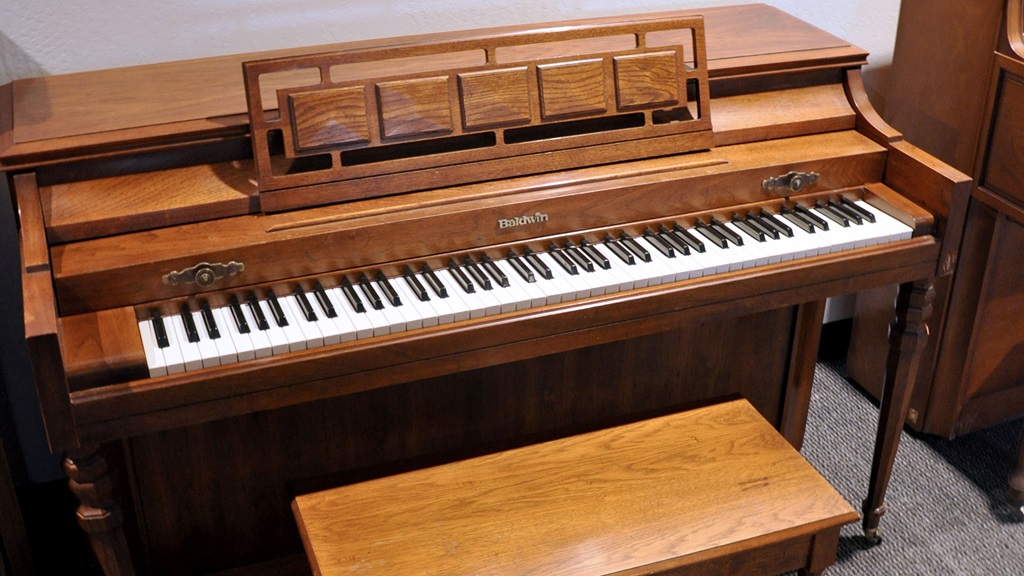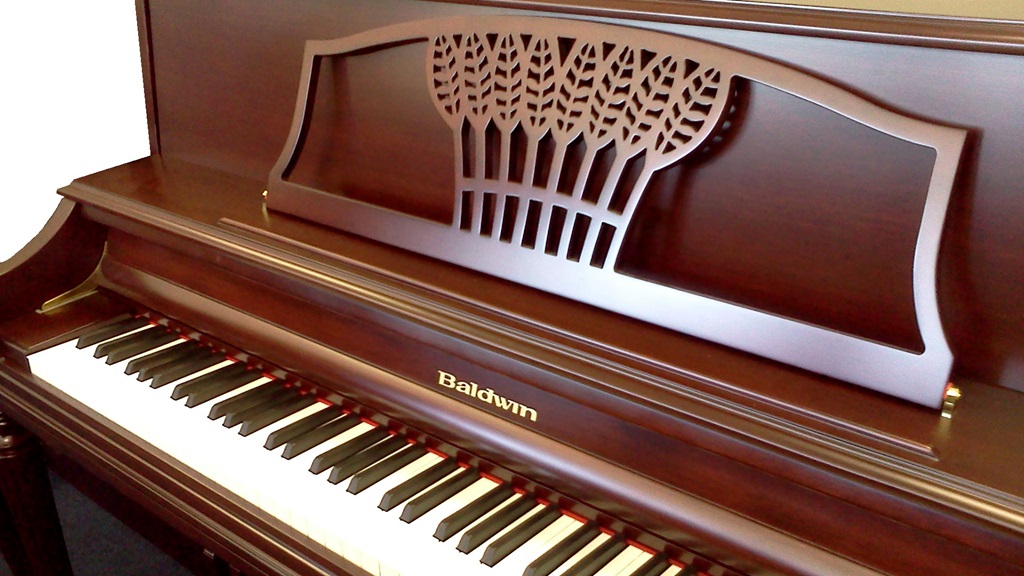Since its inception in 1862 in Cincinnati, Ohio, the Baldwin piano company has been a prominent name in the piano industry. The brand has established a legacy of crafting exceptionally well-made pianos over the years that have been played by some of the most celebrated musicians in the world, including Dave Brubeck, Liberace, and Nat King Cole. However, the Baldwin Acrosonic model has emerged as an iconic masterpiece among all the Baldwin models. Its exquisite design, superior craftsmanship, and unparalleled sound quality make the acrosonic baldwin piano a prized possession for any pianist or music lover.
An Overview of the Distinctive Acrosonic Baldwin Piano
The Acrosonic hit the market in 1951 and enjoyed immense popularity through the 1970s. This spinet piano featured a 36-inch tall case and bold mid-century style design. Early models sported angular edges and tapered legs, exuding the sleek retro-futuristic look of the atomic era.
What truly set the Acrosonic apart was its specialized scaled-down action. This responsive mechanism allowed a Hammond organ-like lightness and speed while still delivering Baldwin’s signature rich tone. Musicians could attack the keys with jazz-like gusto without compromising nuance and expression.
This winning combination made the Acrosonic a top choice for pianists playing lively rhythmic styles like ragtime, boogie-woogie, rock and roll, and jazz. It became a staple in schools, lounges, churches, and homes across America and beyond.
Acrosonic Models and Notable Advancements

The Acrosonic evolved over its nearly 30 year production run. Here are some key models and innovations:
- 1951: The first Acrosonic models debut featuring mahogany frames and spruce soundboards.
- 1952: The mechanisms are now made with all aluminum parts for better reliability.
- Late 1950s: New Tension Resonator bars are added to enhance tone and sustain. Models now tout the updated name “Acrosonic by Baldwin”.
- 1960s: Walnut later rosewood veneers become standard for a more premium look. The L-shaped tapered legs receive adjustable brass kickplates.
- 1966: The deluxe Acrosonic Baldwin Hamilton spinet is introduced with full-width music desk and bench. It has an MSRP of $695, equivalent to over $5,800 today!
- 1970s: Teak finishes and acrylic tops come into vogue, following popular interior design trends. The classic boxy angular style begins transitioning to more rounded edges.
Despite cosmetic changes, the signature performance and appeal of the Acrosonic endured over generations of pianists.
Why Musicians Adored the Acrosonic
The acrosonic baldwin piano earned a revered reputation among gigging musicians for good reason. Here are some of its most cherished attributes:
- Light action: The responsive scaled-down action followed players’ fingers effortlessly. This enabled lively playing styles demanding quick repetition without fatiguing.
- Big tone: Despite the short action, the Acrosonic produced incredibly full rich tones comparable to larger grand pianos. The special aluminum frame and wood soundboard projected sound beautifully.
- Compact size: The Acrosonic had the lowest height (36”) of any Baldwin spinet. This made it easier to transport and fit into tight spaces, ideal for touring musicians.
- Hip style: The sleek mid-century look perfectly matched the atomic jazz-age aesthetic. Owning an Acrosonic became a status symbol.
- Playability: The Acrosonic was lauded by pianists for unmatched playability. The responsive action, dynamic range, and singing tone worked together to inspire musicians.
- Durability: Baldwins were American-made with superb engineering. Many Acrosonics played regularly are still performing flawlessly decades later.
Thanks to these strengths, the Acrosonic became ubiquitous in the postwar era music scene.
Famous Acrosonic Players
The Acrosonic gained immense popularity across genres. Many icons of 20th century music became closely associated with the instrument:
- Dave Brubeck: The jazz giant practiced daily on his Acrosonic. His 1959 album Time Out featuring “Take Five” was hugely influential.
- George Shearing: The blind British jazz pianist performed extensively on an Acrosonic modified with Braille markers.
- Ramsey Lewis: The jazz bandleader and pianist tickled the ivories on an Acrosonic on hits like “The In Crowd”.
- Duane Eddy: The “King of Twang”, famous for songs like “Rebel Rouser”, often played an Acrosonic on tour and appearances.
- Johnnie Johnson: Chuck Berry’s longtime pianist backed up countless hits like “Johnny B. Goode” on his trusty Acrosonic.
- Liberace: The flamboyant showman adored his custom engraved Acrosonic and frequently appeared with it on TV.
- Nat King Cole: The velvety crooner, known for “Unforgettable”, filmed 1960s TV specials featuring his Acrosonic in his living room.
This diversity of star players underscores the Acrosonic’s versatile musicality.
Collectability and Restoration
Thanks to their stellar reputation and historical significance, vintage Acrosonics are highly sought after by collectors and players today. Models from the 1950s and 60s often fetch over $1,000 in playable condition. Pristine examples can command upwards of $3,000-$4,000.
Many private owners and professional piano restoration experts take great pains to refurbish these instruments to their original glory. This can involve re-felting, re-pinning, refinishing, and décor touch ups. Parts like keys, dampers, and actions may need replacement too.
When professionally restored, these timeless Acrosonics play and look as exquisite as the day they left the factory. Their enduring musicality and charm keeps the legend of the Acrosonic alive.
Acrosonic Models Still in Production
Baldwin ceased production of the classic Acrosonic in the early 1980s as tastes changed. But in recent years, several companies have reissued updated versions that aim to capture the vintage vibe:
- Baldwin: Baldwin offers Made-in-America Acrosonic models with traditional cabinetry and their renowned quality action.
- Galaxy: This brand reproduces vintage-style Acrosonics with a glossy French polish finish and patented frictionless keys.
- Sauter: They market the Acrosonic Model 114, an affordably-priced golden oak spinet with German engineering and 5 year warranty.
While not identical to the originals, these neo-Acrosonics carry on the legacy in an authentic way for new generations.
Acrosonic Sound and Style Lives On

Over seven decades since its debut, the distinctive Acrosonic sound resonates. Concert videos of today’s jazz and ragtime pianists often reveal them playing on lovingly maintained vintage Acrosonics. The lively, articulate tone cuts right through the mix.
Yamaha, Kawai, and other leading brands also continue advancing the technology behind fast piano actions. But the original Acrosonic remains a high watermark. For those lucky enough to own this postwar classic, it’s not hard to understand why it occupies such a coveted place in music history.
Conclusion
The Acrosonic Baldwin piano represented a pivotal innovation in American musical history. This iconic spinet combined a specialized light action with robust construction to provide unparalleled playability. The lively, singing tone and sleek mid-century style made the Acrosonic wildly popular across genres. Jazz greats like Dave Brubeck and George Shearing cemented its legend. Collectors and players who appreciate their timeless musical magic actively seek mint-condition Acrosonics today. Though production ceased decades ago, the Acrosonic’s reputation and signature sound carry on, inspiring new generations of pianists.
Frequently Asked Questions
What years was the Acrosonic made?
The Acrosonic was first introduced in 1951 and was produced through the late 1970s, with the peak years of popularity being the 1950s and 1960s.
Why was the Acrosonic action different than other Baldwins?
The Acrosonic featured a specialized “scaled down” action that had shorter key lengths and lighter touch than full-sized Baldwin actions. This enabled a very quick and light playing style suitable for jazz, ragtime, etc.
How many Acrosonic models were there?
There were many different Acrosonic models through the years including the L, M, R, and Hamilton. They differed visually in cabinets, legs, finishes but shared the signature action.
Who were some famous Acrosonic players?
Famous musicians who used the Acrosonic included jazz pianists Dave Brubeck, Ramsey Lewis, and George Shearing, ragtimer Johnny Maddox, rock & rollers Johnnie Johnson and Duane Eddy, and Liberace.
Why are vintage Acrosonics so valued by collectors today?
Vintage Acrosonics from the 1950s and 1960s are prized for their historic significance, quality craftsmanship, great playability, and iconic mid-century style. Well-restored examples can sell for over $4000.







